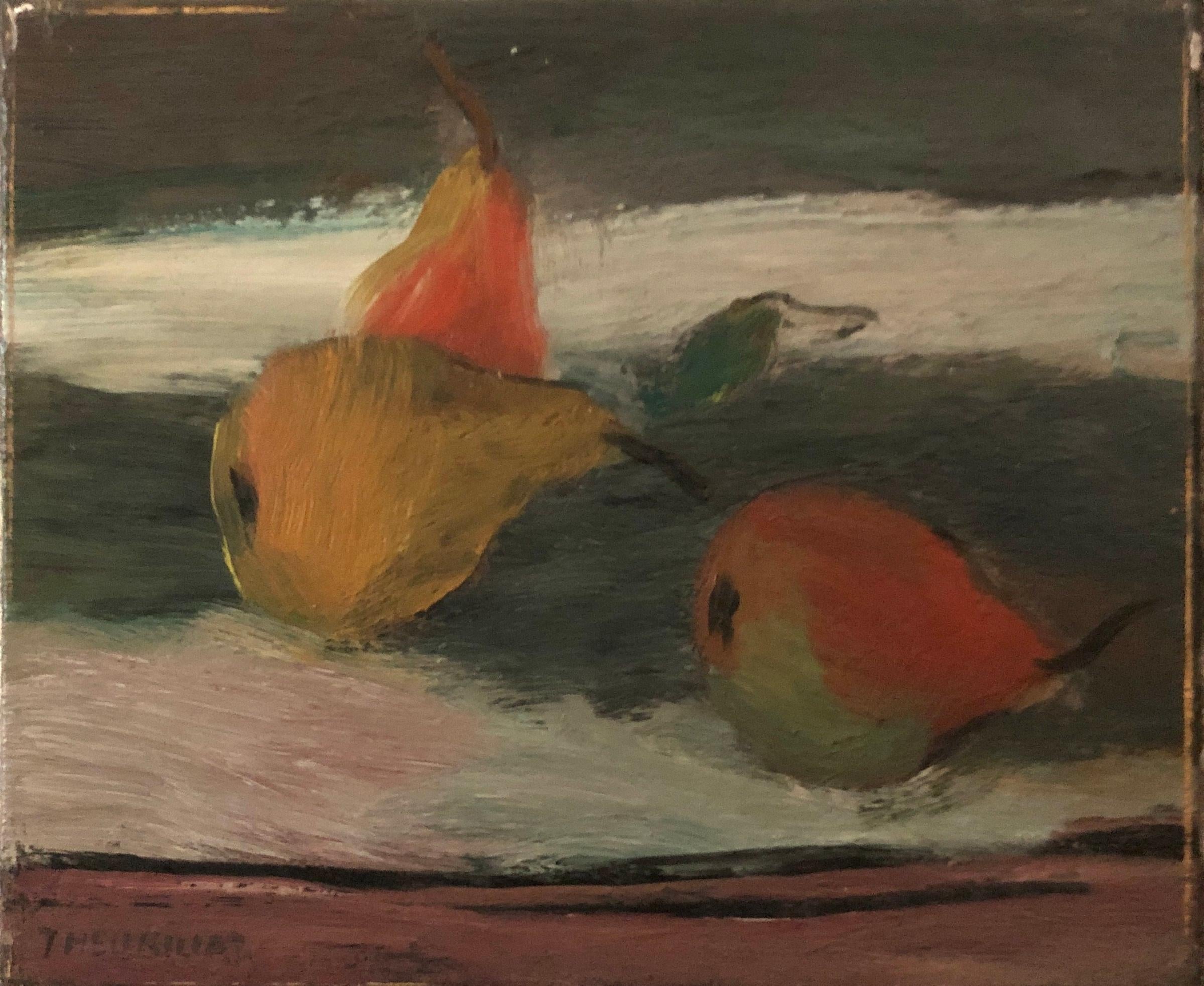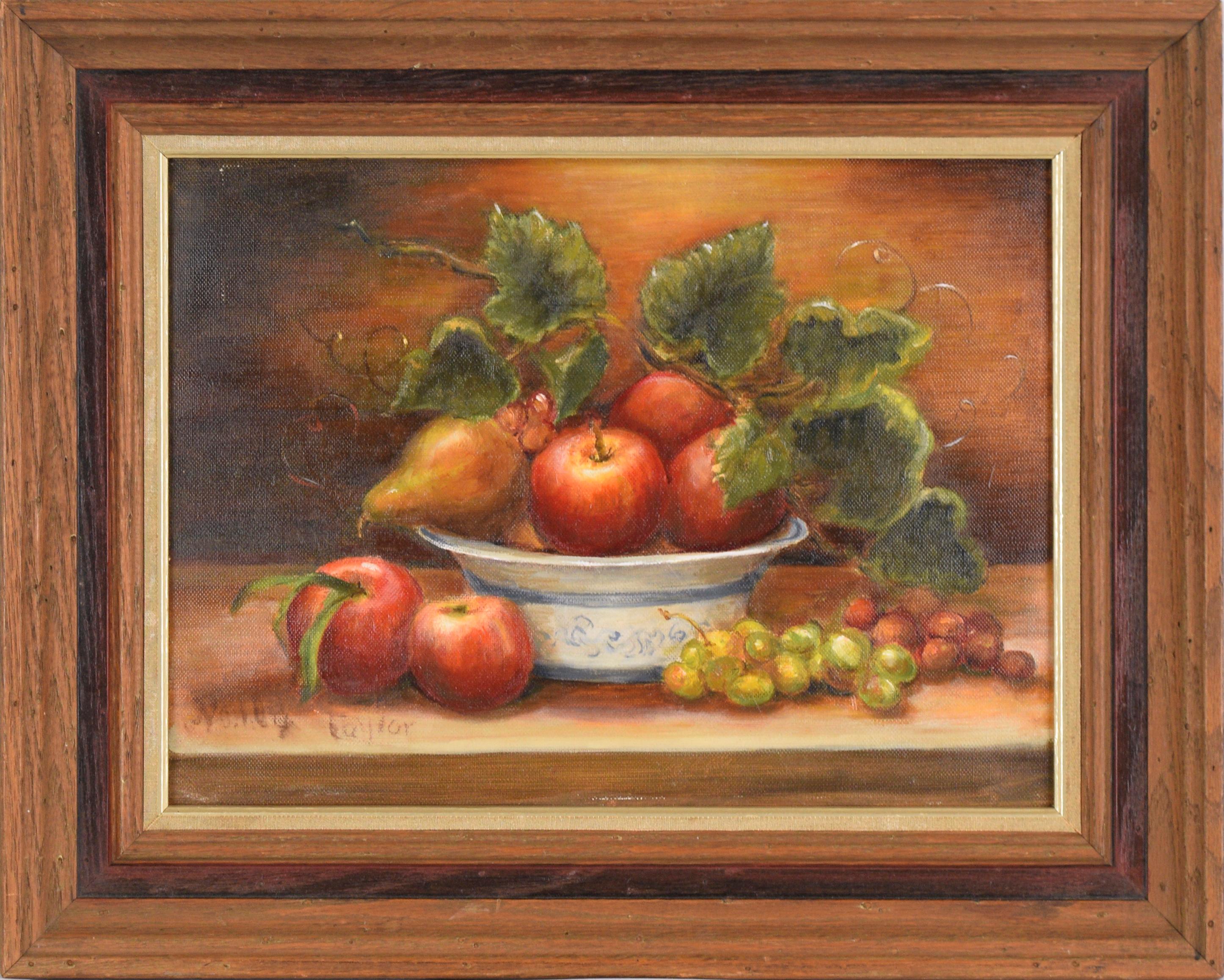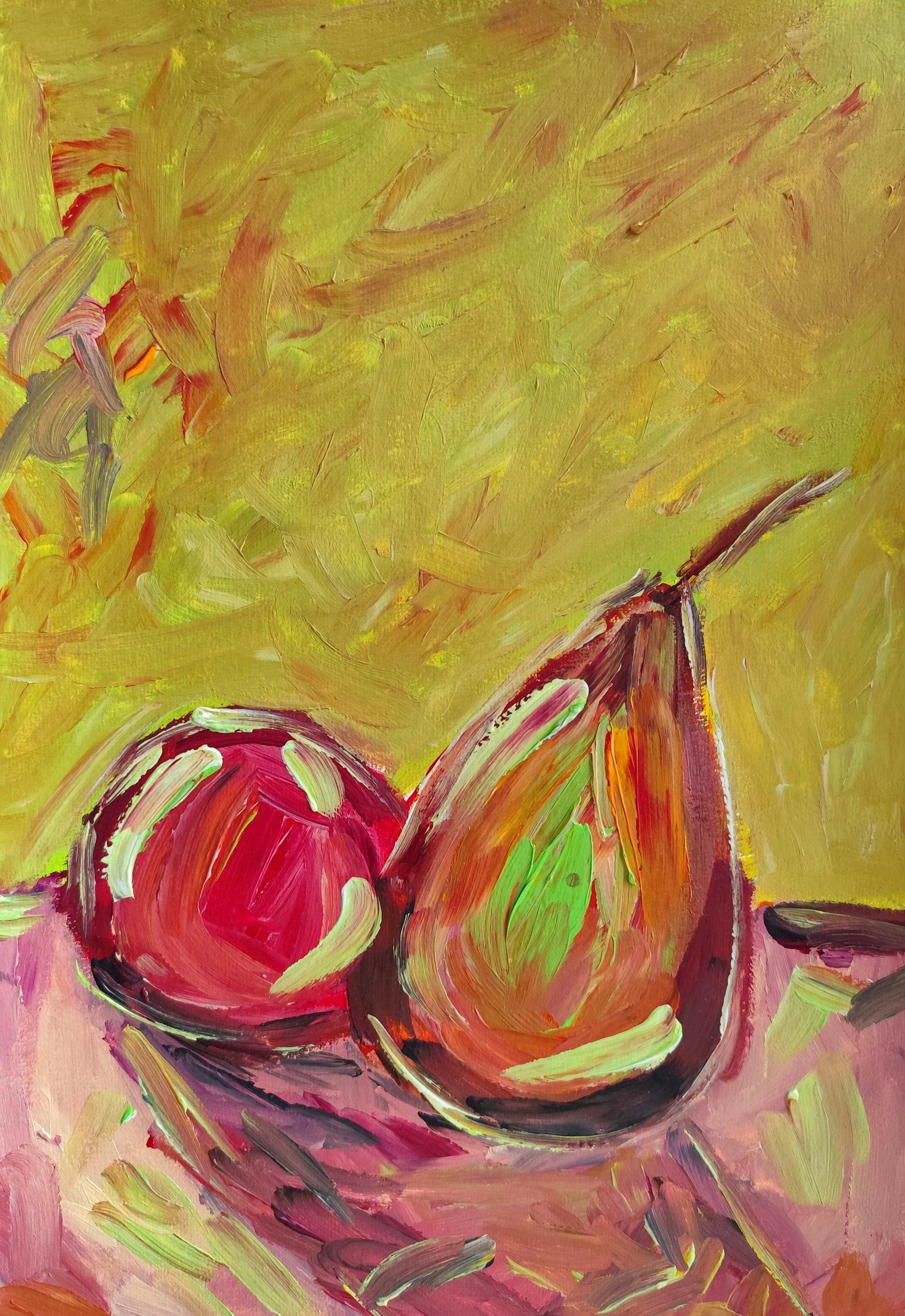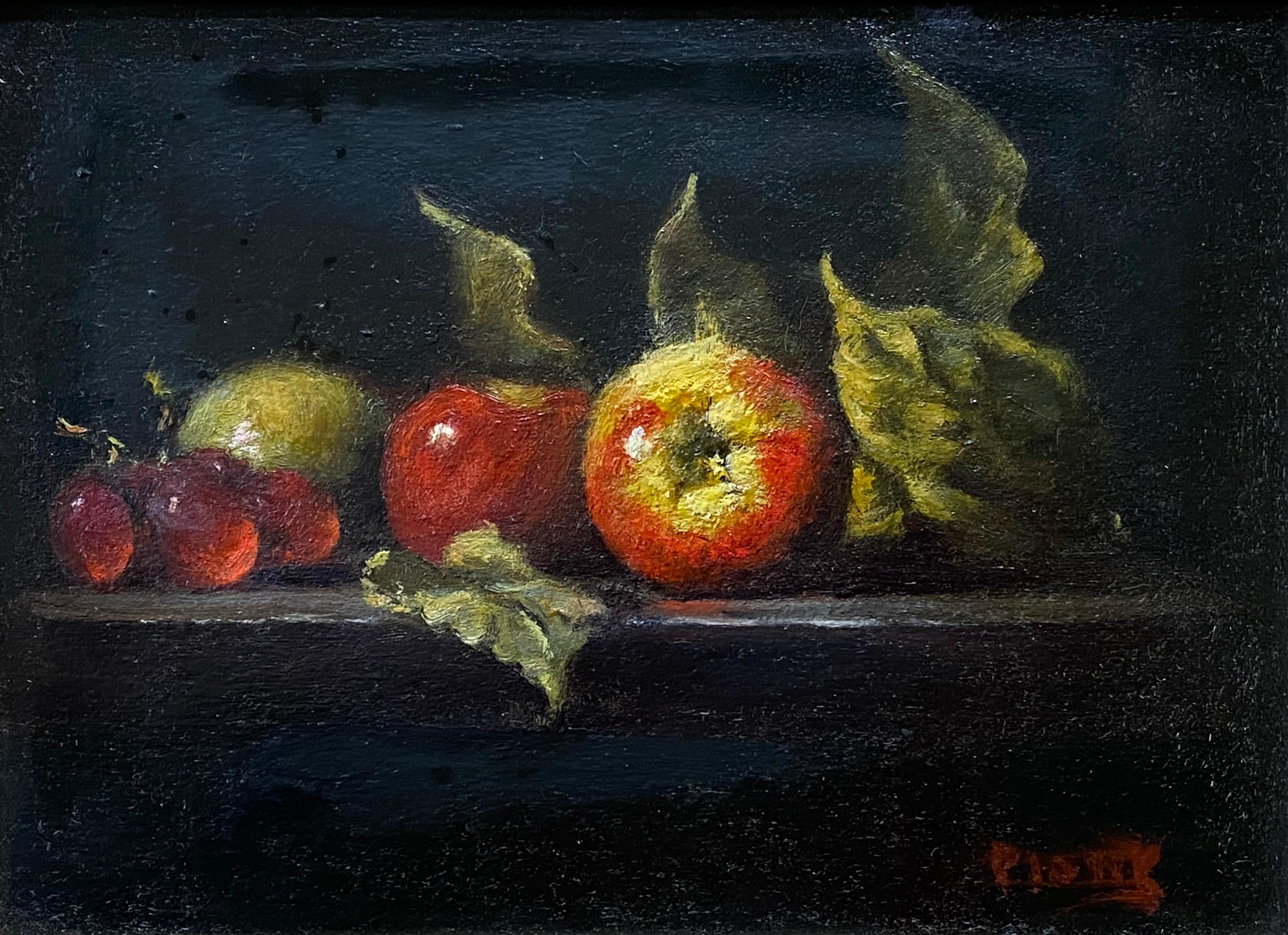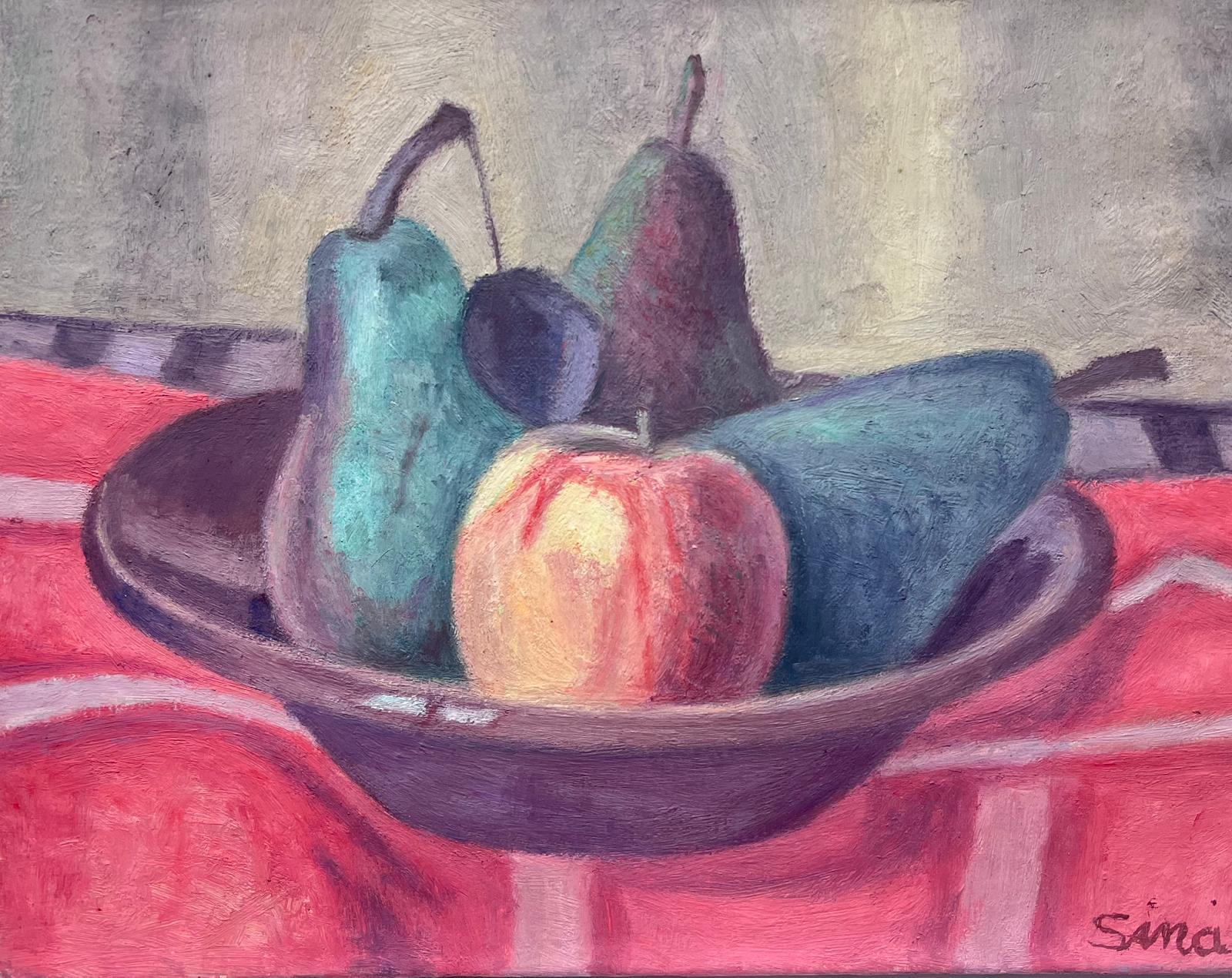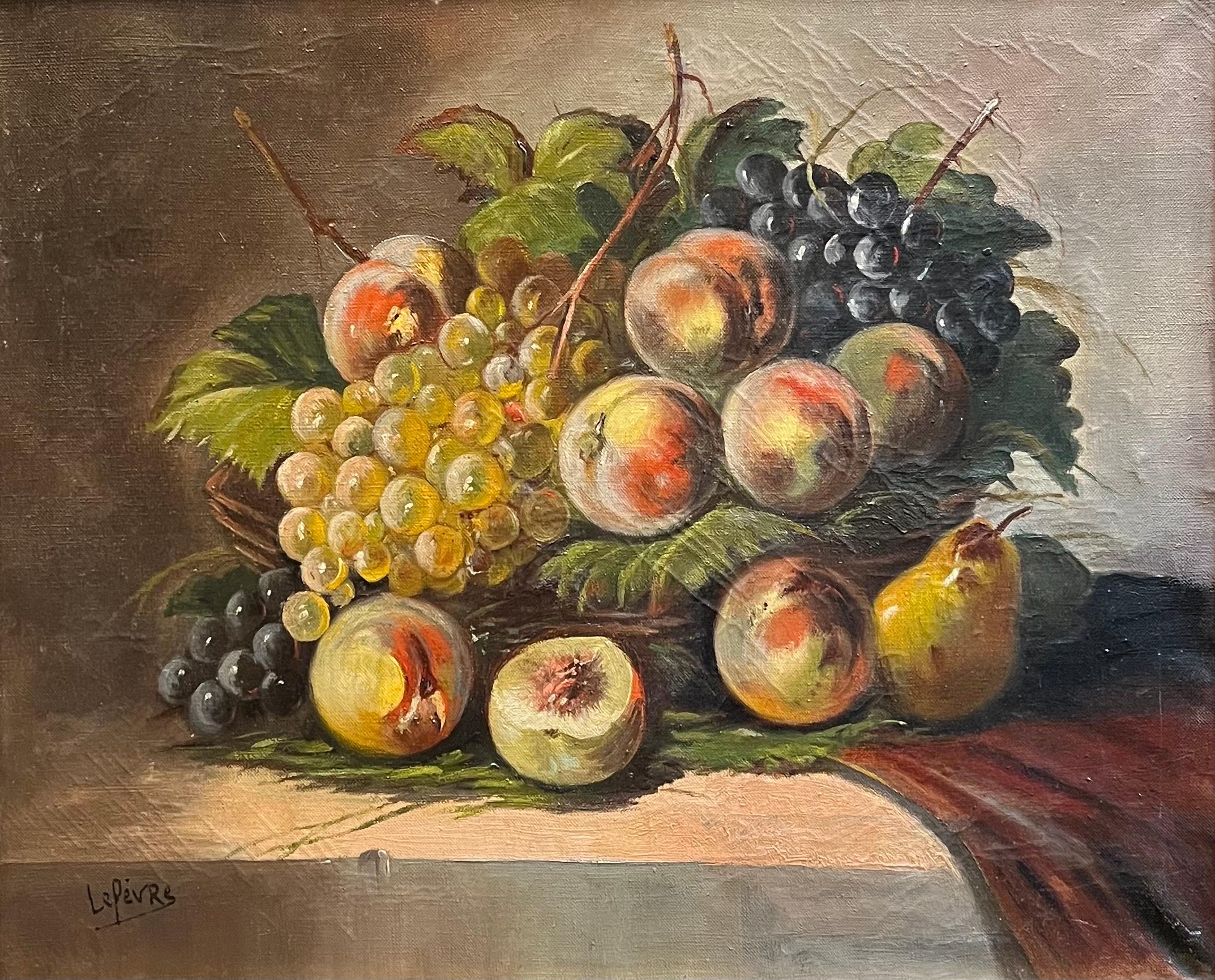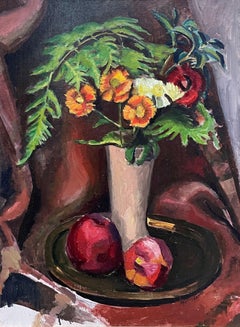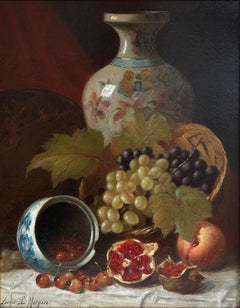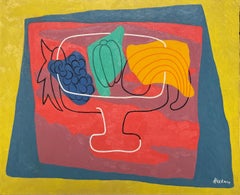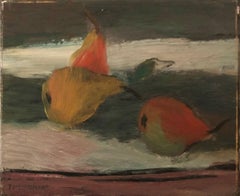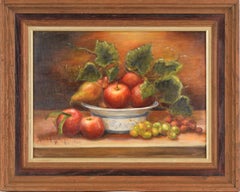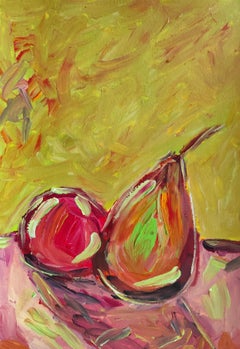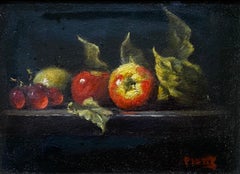Items Similar to "Fruit" Georgina Klitgaard, Apples and Pears Still Life, Woodstock Female Artist
Want more images or videos?
Request additional images or videos from the seller
1 of 11
Georgina Klitgaard"Fruit" Georgina Klitgaard, Apples and Pears Still Life, Woodstock Female Artist
$2,000
$2,50020% Off
£1,529.11
£1,911.3820% Off
€1,761.22
€2,201.5320% Off
CA$2,802.61
CA$3,503.2720% Off
A$3,128.85
A$3,911.0720% Off
CHF 1,639.47
CHF 2,049.3420% Off
MX$38,300.25
MX$47,875.3120% Off
NOK 20,821.32
NOK 26,026.6520% Off
SEK 19,631.86
SEK 24,539.8220% Off
DKK 13,144.18
DKK 16,430.2220% Off
About the Item
Georgina Klitgaard
Apples and Pears Still Life
Signed lower right
Oil on canvas
8 x 10 inches
Georgina Klitgaard’s art has sometimes gotten lost in the critical propensity to assign artists to membership in one school or another. Unfortunately for her posthumous reputation, Klitgaard defied easy characterization. She was a U.S. modernist, working in both oil and watercolors, but never abandoned figurative painting. She made her reputation in landscape but also excelled in portraits, flower studies, and even cityscapes. Yet despite Klitgaard’s ambiguous status in art history, her paintings continue to fascinate viewers attracted to the unsteady ground between twentieth-century realism and expressionism.
Georgina Klitgaard (née Berrian) was born in Spuyten Duyvil, New York (now part of the Bronx); the Berrians had lived in the area since at least the U.S. Revolution. After graduating from Barnard College, she studied art at the National Academy of Design. In 1919 she married Kay Klitgaard, a Danish artist and writer. The next year, her life took a decisive turn when the couple visited friends in Woodstock, NY—about 120 miles north of New York City--and fell in love with the area.
In 1906, L. Birge Harrison helped found the Art Students League Summer School in Woodstock and the area became a magnet for landscape painters. The Klitgaards bought a house in 1922 on a steep ledge at the end of Cricket Ridge, high above Bearsville, which provided panoramic vistas overlooking the Catskill Mountains and the Hudson Valley. Klitgaard joined the artists’ colony in the area, which at the time included artists Ernest Fiene and Katherine Schmidt.
Klitgaard exhibited widely and her career slowly developed momentum. She was a regular contributor at Whitney Museum shows from 1927 to 1944. In 1929, she exhibited a painting entitled “Carousel” in the Whitney Studio Club’s famous exhibition “Circus in Paint.” Gertrude Vanderbilt Whitney acquired five paintings by Klitgaard in the early 1930s and served as a significant patron for the artist. Klitgaard s New York dealer, Frank Rehn Galleries, exhibited her work from 1930 through the 1950s.
During the Great Depression, the Works Progress Administration commissioned Klitgaard to create murals for three U.S. post offices: Goshen (1937) and Poughkeepsie (1940) in New York, and Pelham, Georgia (1941). Klitgaard’s Goshen mural, “The Running of the Hambletonian Stake,” was controversial for featuring harness racing, a theme still considered of questionable taste for public art even though it was the village’s claim to fame.
Although Klitgaard had a studio 659 Fifth Avenue in New York City, she traveled widely in the United States including New England, Florida, and the Santa Fe area. In 1933, Klitgaard received a Guggenheim Fellowship which provided money for her to tour Europe. Seven years later, the family traveled the United States while Kaj used the trip as background for his book, Through the American Landscape (published in 1941).
However, the bulk of Klitgaard’s work was painted around the Woodstock area. She was best known for wide landscapes of her beloved upstate New York, sometimes drifting into a tonalist preoccupation with seasons, mists, sunrises, and atmosphere. Klitgaard achieved her effects by limiting her palette and attempting to reduce her composition to a few simple forms. This sense of restraint allowed her to retain a sense of place and approach abstraction without jettisoning figurative landscapes. One critic wrote that her Woodstock landscapes looked like “Currier and Ives lithographs with little clouds and precise arrangements of facts.” Lloyd Goodrich, the noted art historian, praised her “lively sense of movement and a feeling for light and air with a sort of cool detached lyricism.”
When Klitgaard died in 1976, she seemed out of fashion, detached from almost all postwar art trends. However, in the twenty-first century, she has benefitted from the renewed interest in the prominent female modernists who prospered during the interwar years. Her paintings remain exemplary examples of conservative American modernism.
- Creator:Georgina Klitgaard (1893-1976, American)
- Dimensions:Height: 13 in (33.02 cm)Width: 15 in (38.1 cm)
- Medium:
- Movement & Style:
- Period:
- Condition:
- Gallery Location:New York, NY
- Reference Number:1stDibs: LU1841214091352
Georgina Klitgaard
Georgina Berrian was born in Spuyten Duyvil, New York in 1893. She was educated at Barnard College and studied at the National Academy of Design in New York. She married the Danish-born mariner, artist, and writer Kaj Klitgaard in 1919. After visiting friends in Woodstock, the couple became committed to the area and built a home in 1922 in Bearsville which provided a panoramic view of the mountains and valleys of Woodstock. Georgina Klitgaard's first exhibition in New York was held at the Whitney Studio Club from Dec.20, 1927 to January 7, 1928. Klitgaard's New York dealer was the Frank Rehn Galleries, where she began to exhibit in the 1930s, continuing that relationship into the 1950s. In 1939 and again in 1940 she had solo exhibitions with the Milch Gallery in New York. By the late 1920s, Klitgaard began to show works at museum invitationals. She sent work to the Carnegie International in Pittsburgh, Pennsylvania each year from 1928 to 1949. The Corcoran Gallery of Art in Washington, DC invited Klitgaard to exhibit each year from 1930 to 1945. Klitgaard also exhibited works at the Virginia Museum of Fine Art in Richmond and the Pennsylvania Academy of the Fine Arts in Philadelphia from 1930 to 1945 annually. Klitgaard was also invited to exhibit regularly at the Whitney Museum of American Art from 1927 to 1944. In the 1936 works on paper component of the Whitney Biennial, Klitgaard exhibited Florida Landscape (No.116, a work on paper). In 1944 Klitgaard exhibited another Florida work, Early Spring, Florida (No. 7) at the Whitney. Based on this information, it seems likely that Klitgaard began to visit Florida in the winter during the 1930s and continued to do so until the 1940s. Many of her Woodstock artist friends, such as Doris Lee (1905-1983), found a way to spend time in Florida during the winter on a regular basis. Their experiences in Florida may have influenced Klitgaard to visit. In 1933 Georgina Klitgaard received a Guggenheim Fellowship which provided funds to travel in Europe. In 1940 the family traveled around the U.S. while Kaj, himself now the recipient of a Guggenheim, wrote Through the American Landscape. During the Depression she was selected to paint murals in post offices in Pelham, Georgia and Goshen (1937) and Poughkeepsie (1940) in Upstate New York. The Metropolitan Museum of Art acquired Girl and Child Under A Pine Tree, a colorful portrait, in 1939. By the 1940s Klitgaard's work was also in the permanent collections of the Whitney Museum of American Art; the Newark Museum; the New Britain Museum of American Art; and the Dayton Art Institute, as well as other public and private collections. Klitgaard was a member of the Audubon Artists and the American Society of Painters, Sculptors, and Gravers. She had a studio in New York City located at 659 Fifth Avenue. Klitgaard died in 1976. The bulk of her exhibited subjects were painted around the Woodstock or Bearsville area.
About the Seller
5.0
Platinum Seller
Premium sellers with a 4.7+ rating and 24-hour response times
Established in 2022
1stDibs seller since 2022
115 sales on 1stDibs
Typical response time: <1 hour
- ShippingRetrieving quote...Shipping from: New York, NY
- Return Policy
Authenticity Guarantee
In the unlikely event there’s an issue with an item’s authenticity, contact us within 1 year for a full refund. DetailsMoney-Back Guarantee
If your item is not as described, is damaged in transit, or does not arrive, contact us within 7 days for a full refund. Details24-Hour Cancellation
You have a 24-hour grace period in which to reconsider your purchase, with no questions asked.Vetted Professional Sellers
Our world-class sellers must adhere to strict standards for service and quality, maintaining the integrity of our listings.Price-Match Guarantee
If you find that a seller listed the same item for a lower price elsewhere, we’ll match it.Trusted Global Delivery
Our best-in-class carrier network provides specialized shipping options worldwide, including custom delivery.More From This Seller
View All"Still Life of Fruit " Albert Swinden, American Abstract Association, AAA
By Albert Swinden
Located in New York, NY
Albert Swinden (1901 - 1961)
Still Life of Fruit, 1937
Oil on canvas
18 x 30 inches
Provenance:
Graham Gallery, New York
Albert Swinden (1901–1961) was an English-born American abstract painter. He was one of the founders of the American Abstract Artists, and he created significant murals as part of the Federal Art Project.
Albert Swinden was born in Birmingham, England in 1901. When he was seven, he moved with his family to Canada, and in 1919 he immigrated to the United States. He lived in Chicago, where he studied for about a year and a half at the Art Institute. He then relocated to New York City, where his art education continued briefly at the National Academy of Design. He soon changed schools again, to the Art Students League, which he attended from 1930 to 1934. He studied with Hans Hofmann and gained an appreciation for Synthetic Cubism and Neoplasticism. According to painter and printmaker George McNeil, Swinden "could have influenced Hofmann ... He was working with very, very simple planes, not in this sort of Cubistic manner. Swinden was working synthetically at this time." While still a student, Swinden began teaching at the Art Students League, in 1932.
Swinden married Rebecca Palter (1912–1998), from New York. Their daughter, Alice Swinden Carter, also became an artist. Carter, who attended the School of the Museum of Fine Arts, Boston, received an award from the Institute of Contemporary Art, Boston for her large sculptures.
Swinden was hired for the Federal Art Project (FAP) of the Works Progress Administration (WPA), and he is best known for the murals which he painted as part of that project.
In 1935, New York City Mayor Fiorello La Guardia attended the opening of the inaugural exhibit at the Federal Art Project Gallery, accompanied by Audrey McMahon, New York regional director for the Works Progress Administration/Federal Art Project. Among the works on display was Abstraction, a sketch by Swinden; it was the design for a mural planned for the College of the City of New York. A newspaper account described it as consisting of "brightly colored T-squares, triangles and rulers in horizontal, vertical and diagonal positions". La Guardia asked what it was, and upon being told it was a mural design, he said he didn't know what it depicted. Someone joked that it could be a map of Manhattan. The displeased mayor stated that "if that's art, I belong to Tammany Hall." (Tammany Hall, which the Republican mayor referenced, was the New York Democratic Party political society.) Fearing that the mayor's negative attitude could jeopardize the future of abstract art within the Federal Art Project, McMahon dispatched an assistant to summon an artist who could speak to the mayor in defense of abstraction. The assistant returned with Arshile Gorky.
Swinden played an important role in the founding of the American Abstract Artists. In 1935, he met with three friends, Rosalind Bengelsdorf, her future husband Byron Browne, and Ibram Lassaw, with the goal of exhibiting together. The group grew and started meeting in Swinden's studio, which adjoined those of Balcomb and Gertrude Greene...
Category
1930s Modern Still-life Paintings
Materials
Canvas, Oil
$4,800 Sale Price
20% Off
"Floral Still Life with Two Apples" Hayley Lever, Modernist Still Life Painting
By Hayley Lever
Located in New York, NY
Hayley Lever
Floral Still Life with Two Apples
Signed lower right
Oil on canvas
20 x 16 inches
Hayley Lever’s versatility has worked against his posthumous reputation. He was never...
Category
Early 20th Century Modern Still-life Paintings
Materials
Canvas, Oil
"Still Life with Cherries, Grapes" Annie L. Morgan, Academic Fruit Still Life
Located in New York, NY
Annie L. Morgan
Still Life with Cherries, Grapes, and Pomegranate, circa 1880
Signed lower left
Oil on canvas
20 x 16 inches
Category
1880s Academic Figurative Paintings
Materials
Canvas, Oil
"Untitled" Albert Heckman, circa 1950 Modernist Colorful Still Life With Fruit
By Albert Heckman
Located in New York, NY
Albert Heckman
Untitled, circa 1950
Signed lower right
Oil on canvas
24 x 30 inches
Albert Heckman was born in Meadville, Western Pennsylvania, 1893. He went to New York City to try his hand at the art world in 1915 after graduating from high school and landing a job at the Meadville Post Office. In 1917, at the age of 24, Heckman enrolled part-time in Teachers' College, Columbia University's Fine Arts Department to begin his formal art education. He worked as a freelance ceramic and textile designer and occasionally as a lecturer at the Metropolitan Museum of Art. In the early 1920s, at the age of almost 30, he graduated with a Bachelor of Arts degree from Columbia Teachers College. He was especially impacted by his instructor at Columbia, Arthur Wesley Dow.
After graduating, he was hired by the Teachers' College as a Fine Arts instructor. He stayed with Columbia Teachers' College until 1929, when he left to attend the Leipzig Institute of Graphic Arts in Leipzig, Germany. Isami Doi (1903-1965), who was born in Hawaii, was arguably his most impressive student at Columbia. Doi is now regarded as one of the most prominent artists hailing from Hawaii. Heckman became an active member and officer of the Keramic Society and Design Guild of New York in the 1920s as part of his early commercial art career. The Society's mission was to share knowledge and showcase textile and ceramic design exhibits.
In 1922, Heckman married Florence Hardman, a concert violinist. Mrs. Heckman's concert schedule during the 1920s kept Albert and Florence Heckman apart for a significant portion of the time, but they spent what little time they had together designing and building their Woodstock, New York, summer house and grounds. A small house and an acre of surrounding land on Overlook Mountain, just behind the village of Woodstock, were purchased by Albert and Florence Heckman at the time of their marriage. Their Woodstock home, with its connections, friendships, and memories, became a central part of their lives over the years, even though they had an apartment in New York City.
Heckman's main artistic focus shifted to the house on Overlook Mountain and the nearby towns and villages, Kingston, Eddyville, and Glasco. After returning from the Leipzig Institute of Graphic Arts in 1930, Mr. Heckman joined Hunter College as an assistant professor of art. He worked there for almost thirty years, retiring in 1956. Throughout his tenure at Hunter, Mr. Heckman and his spouse spent the summers at their Woodstock residence and the winters in New York City. They were regular and well-known guests at the opera and art galleries in New York. Following his retirement in 1956, the Heckmans settled in Woodstock permanently, with occasional trips to Florida or Europe during the fall and winter. Mr. Heckman's close friends and artistic career were always connected to Woodstock or New York City. He joined the Woodstock art group early on and was greatly influenced by artists like Paul and Caroline Rohland, Emil Ganso, Yasuo Kuniyoshi, Andre Ruellan, and her husband, Jack...
Category
1950s Modern Interior Paintings
Materials
Canvas, Oil
Pair of Fruit Still Lifes, Sarah Miriam Peale, Cherries and Raspberries Basket
Located in New York, NY
A pair of still lifes:
Sarah Miriam Peale
Cherries, circa 1860
Oil on canvas
12 x 10 inches
Provenance:
Kennedy Galleries, New York
Private Collection (acquired from the above in 1966)
Exhibited:
Baltimore, Maryland, Peale Museum, Miss Sarah Miriam Peale: 1800-1885, Portraits and Still Life, 1967, no. 42, p. 17, illustrated.
Philadelphia, Philadelphia Museum of Art, The Peale Family: Creation of an American Legacy, 1770-1870, 1996-97, pl. 61, p. 97, illustrated; this exhibition later traveled to Washington, D.C., National Portrait Gallery; Washington, D.C., Corcoran Gallery of Art; San Francisco, M.H. de Young Memorial Memorial Museum.
Sarah Miriam Peale
Basket with Berries, circa 1860
Oil on canvas
12 x 10 inches
Provenance:
Kennedy Galleries, New York
Private Collection (acquired from the above in 1966)
Exhibited:
Baltimore, Maryland, Miss Sarah Miriam Peale: 1800-1885, Portraits and Still Life, 1967, no. 43, p. 34, illustrated.
Philadelphia, Philadelphia Museum of Art, The Peale Family: Creation of an American Legacy, 1770-1870, 1996-97, pl. 125, pp. 245-46, illustrated; this exhibition later traveled to Washington, D.C., National Portrait Gallery; Washington, D.C., Corcoran Gallery of Art; San Francisco, M.H. de Young Memorial Memorial Museum.
One of the many artist descendants of Charles Willson...
Category
1860s Still-life Paintings
Materials
Canvas, Oil
"An Orange Seducing a Lemon while a Bunch of Grapes Look On" Edward Zutrau, 1953
Located in New York, NY
Edward Zutrau
An Orange Seducing a Lemon while a Bunch of Grapes Look On, 4/20/1953
Signed, dated and titled on stretcher bar, and on the side of the work
Oil on linen
18 x 21 inches...
Category
1950s Abstract Expressionist Abstract Paintings
Materials
Canvas, Oil
You May Also Like
Still life with pears
Located in Genève, GE
Work on canvas
Category
1940s Modern Still-life Paintings
Materials
Oil
"Apples, Grapes, and Pears" Still Life
Located in Soquel, CA
Idyllic still life with fruit by American artist Nancy Taylor (20th century). A lush grave vine is perched atop a bowl of apples and pears. Two more apple...
Category
Late 20th Century American Impressionist Still-life Paintings
Materials
Canvas, Oil, Cardboard
$260 Sale Price
20% Off
Contemporary expressionist still life fruit painting "One apple, one pear"
Located in VÉNISSIEUX, FR
This contemporary abstract expressionist still life painting, created by French artist Natalya Mougenot, is part of her ongoing still life series that celebrates the beauty of everyd...
Category
2010s Abstract Impressionist Still-life Paintings
Materials
Paper, Acrylic
“Still Life with Apples”
Located in Southampton, NY
Here for your consideration is a very well executed still life with apples by the American artist, Richard C. Pionk. Signed lower right “Pionk”. Oil paint on card stock. Condition is excellent. Circa 1980. The artwork is housed in a gold leaf gallery frame from the period which is in fine condition. Overall framed measurements are 10.75 by 12.75 inches. Provenance: A Ellenton, Florida estate.
Richard Cletus Pionk (April 26, 1936 – June 5, 2007), beloved instructor of painting at the Art Students League of New York and president of the Salmagundi Club, died June 5, 2007, but his work stands as a masterclass in still life painting, primarily in oils and pastels.
Born April 26, 1936 in Moose Lake, Minnesota Pionk moved to New York City where he made a life revolving around painting and teaching.
Best known for his still lifes, portraits, and interior scenes in oils and pastels, Pionk learned much about classical still life painting by spending hours in his beloved museums, including the Brooklyn Museum and other New York museums, as well as the École du Louvre in Paris. Pionk studied the works of many artists, in particular Jean-Baptiste-Siméon Chardin, Antoine Vollon, and Henri Fantin-Latour.
He also studied with Daniel Green and Sidney E. Dickinson at the Art Students League of New York. He later taught there, and at the Pastel Society of America School and the National Arts Club in New York. He was also the longest running president of the Salmagundi Club.
During his accomplished art career, Pionk earned more than 100 awards from the Pastel Society of America, Audubon Artists, National Arts Club, and numerous other professional associations. In 1984, he was named Master Pastelist by the Pastel Society of America, and in 1997 was inducted into the Pastel Hall of Fame. In 1994, his work was included in the Taiwanese exhibit, “Contemporary Pastel Artists...
Category
1980s Contemporary Still-life Paintings
Materials
Oil, Archival Paper
$1,480 Sale Price
20% Off
French Post-Impressionist Still Life Pear and Apples Fruit In Bowl
Located in Cirencester, Gloucestershire
signed Sinai
French Post-Impressionist School, late 20th century
oil painting on canvas, unframed
canvas: 10.75 x 14 inches
provenance: private collection
condition: very good and so...
Category
20th Century Post-Impressionist Interior Paintings
Materials
Oil
"Still Life with Fruits" by Marie Lefèvre - Oil on Canvas - 45x53.5 cm
By Marie Lefevre
Located in Geneva, CH
Artwork sold with frame (62.5x53.5 cm)
Marie Lefevre (born in 1840) was a French painter renowned for her poetic genre scenes and tranquil landscapes, particularly those capturing t...
Category
Late 19th Century Modern Still-life Paintings
Materials
Canvas, Oil
More Ways To Browse
Danish Still Life
Apple Pear
Danish Female Artists
1930s Female Portrait
Fruit Lithograph
1930s Circus Art
1940s Paintings Florida
Antique Carousels
Sunrise Watercolor Painting
Currier And Ives
Antique Currier And Ives
Currier And Ives Lithograph
Harness Racing
Currier Ives New York
Antique Magnets
Pelham Antique
Fruit Basket Still Life Painting
Hyper Realist Still Life Painting
